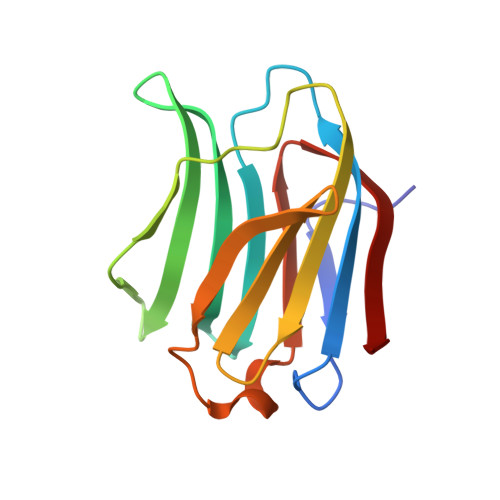Galectin-3 interactions with glycosphingolipids.
Collins, P.M., Bum-Erdene, K., Yu, X., Blanchard, H.(2014) J Mol Biol 426: 1439-1451
- PubMed: 24326249
- DOI: https://doi.org/10.1016/j.jmb.2013.12.004
- Primary Citation of Related Structures:
4LBJ, 4LBK, 4LBL, 4LBM, 4LBN, 4LBO - PubMed Abstract:
Galectins have essential roles in pathological states including cancer, inflammation, angiogenesis and microbial infections. Endogenous receptors include members of the lacto- and neolacto-series glycosphingolipids present on mammalian cells and contain the tetrasaccharides lacto-N-tetraose (LNT) and lacto-N-neotetraose (LNnT) that form their core structural components and also ganglio-series glycosphingolipids. We present crystallographic structures of the carbohydrate recognition domain of human galectin-3, both wild type and a mutant (K176L) that influenced ligand affinity, in complex with LNT, LNnT and acetamido ganglioside a-GM3 (α2,3-sialyllactose). Key structural features revealed include galectin-3's demonstration of a binding mode towards gangliosides distinct from that to the lacto/neolacto-glycosphingolipids, with its capacity for recognising the core β-galactoside region being challenged when the core oligosaccharide epitope of ganglio-series glycosphingolipids (GM3) is embedded within particular higher-molecular-weight glycans. The lacto- and neolacto- glycosphingolipids revealed different orientations of their terminal galactose in the galectin-3-bound LNT and LNnT structures that has significant ramifications for the capacity of galectin-3 to interact with higher-order lacto/neolacto-series glycosphingolipids such as ABH blood group antigens and the HNK-1 antigen that is common on leukocytes. LNnT also presents an important model for poly-N-acetyllactosamine-containing glycans and provides insight into galectin-3's accommodation of extended oligosaccharides such as the poly-N-acetyllactosamine-modified N- and O-glycans that, via galectin-3 interaction, facilitate progression of lung and bladder cancers, respectively. These findings provide the first atomic detail of galectin-3's interactions with the core structures of mammalian glycosphingolipids, providing information important in understanding the capacity of galectin-3 to engage with receptors identified as facilitators of major disease.
Organizational Affiliation:
Institute for Glycomics, Griffith University Gold Coast Campus, Queensland 4222, Australia.
















